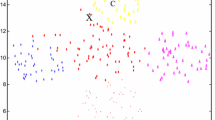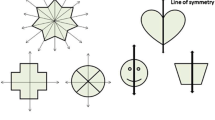Abstract
In this paper, at first a new line symmetry (LS) based distance is proposed which calculates the amount of symmetry of a point with respect to the first principal axis of a data set. The proposed distance uses a recently developed point symmetry (PS) based distance in its computation. Kd-tree based nearest neighbor search is used to reduce the complexity of computing the closest symmetric point. Thereafter an evolutionary clustering technique is described that uses this new principal axis based LS distance for assignment of points to different clusters. The proposed GA with line symmetry distance based (GALS) clustering technique is able to detect any type of clusters, irrespective of their geometrical shape, size or convexity as long as they possess the characteristics of LS. GALS is compared with the existing genetic algorithm based K-means clustering technique, GAK-means, existing genetic algorithm with PS based clustering technique, GAPS, spectral clustering technique, and average linkage clustering technique. Five artificially generated data sets having different characteristics and seven real-life data sets are used to demonstrate the superiority of the proposed GALS clustering technique. In a part of experiment, utility of the proposed genetic LS distance based clustering technique is demonstrated for segmenting the satellite image of the part of the city of Kolkata. The proposed technique is able to distinguish different landcover types in the image. In the last part of the paper genetic algorithm is used to search for the suitable line of symmetry of each cluster.
Similar content being viewed by others
References
Everitt BS, Landau S, Leese M (2001) Cluster analysis. Arnold, London
Jain AK, Murthy M, lynn P (1999) Data clustering: a review. ACM Comput Rev 31: 264–323
Attneave F (1995) Symmetry information and memory for pattern. Am J Psychol 68: 209–222
Bandyopadhyay S, Saha S (2007) GAPS: A clustering method using a new point symmetry based distance measure. Pattern Recognit 40: 3430–3451
Saha S, Bandyopadhyay S (2009) A new line symmetry distance and its application to data clustering. J Comput Sci Technol 24(3): 544–556
Jolliffe I (1986) Principal component analysis. Springer Series in Statistics, England
Maulik U, Bandyopadhyay S (2000) Genetic algorithm based clustering technique. Pattern Recognit 33: 1455–1465
Chen WY, Song Y, Bai H, Lin CJ, Chang EY (2008) PSC: parallel spectral clustering. Software available. http://www.cs.ucsb.edu/~wychen/sc
Bandyopadhyay S, Saha S (2008) A point symmetry based clustering technique for automatic evolution of clusters. IEEE Trans Knowl Data Eng 20(11): 1–17
Mount DM, Arya S (2005) ANN: a library for approximate nearest neighbor searching. http://www.cs.umd.edu/~mount/ANN
Anderberg MR (2000) Computational geometry: algorithms and applications. Springer, New York
Friedman JH, Bently JL, Finkel RA (1977) An algorithm for finding best matches in logarithmic expected time. ACM Trans Math Softw 3(3): 209–226
Srinivas M, Patnaik L (1994) Adaptive probabilities of crossover and mutation in genetic algorithms. IEEE Trans Syst Man Cybern 24(4): 656–667
Ben-Hur A, Guyon I (2003) Detecting stable clusters using principal component analysis in methods in molecular biology. Humana Press, Clifton
Handl J, Knowles J (2007) An evolutionary approach to multiobjective clustering. IEEE Trans Evol Comput 11(1): 56–76
Gonzalez RC, Woods RE (1992) Digital image processing. Addison-Wesley, Massachusetts
Fisher RA (1936) The use of multiple measurements in taxonomic problems. Ann Eugen 3: 179–188
Rudolph G (1994) Convergence analysis of canonical genetic algorithms. IEEE Trans Neural Netw 5(1): 96–101
Krishna K, Murty MN (1999) Genetic k-means algorithm. IEEE Trans Syst Man Cybern Part B 29(3): 433–439
Richards JA (1993) Remote sensing digital image analysis: an introduction. Springer-Verlag, New York
Pal SK, Bandyopadhyay S, Murthy CA (2001) Genetic classifiers for remotely sensed images: comparison with standard methods. Int J Remote Sens 22: 2545–2569
Bandyopadhyay S, Murthy CA, Pal SK (1995) Pattern classification using genetic algorithms. Pattern Recognit Lett 16: 801–808
Wang Y, Li B (2010) Multi-strategy ensemble evolutionary algorithm for dynamic multi-objective optimization. Memetic Comp 2(1): 3–24
Sattar A, Seguier R (2010) HMOAM: hybrid multi-objective genetic optimization for facial analysis by appearance model. Memetic Comp 2(1): 25–46
Gong M, Liu C, Jiao L, Cheng G (2010) Hybrid immune algorithm with Lamarckian local search for multi-objective optimization. Memetic Comp 2(1): 47–67
Kramer O (2010) Iterated local search with powells method: a memetic algorithm for continuous global optimization. Memetic Comp 2(1): 69–83
Martikka HI, Pllnen I (2009) Multi-objective optimization by technical laws and heuristics. Memetic Comp 1(3): 229–238
Author information
Authors and Affiliations
Corresponding author
Rights and permissions
About this article
Cite this article
Saha, S., Bandyopadhyay, S. On principle axis based line symmetry clustering techniques. Memetic Comp. 3, 129–144 (2011). https://doi.org/10.1007/s12293-010-0049-0
Received:
Accepted:
Published:
Issue Date:
DOI: https://doi.org/10.1007/s12293-010-0049-0




